test 4 material – Flashcards
Unlock all answers in this set
Unlock answersquestion
_____% of men diagnosed with prostate cancer live 5+ years
answer
99%
question
Number of men expected to die from prostate cancer in 2009
answer
26,000
question
Incidence of prostate cancer is highest among what race of men? Lowest?
answer
Highest: African-American men Lowest: Asia, North Africa
question
Lifetime risk for man getting prostate cancer is ____ in ______.
answer
1 in 6
question
______% of men over age 65 diagnosed with prostate cancer
answer
70%
question
Prolonged exposure to what is a risk factor for prostate cancer?
answer
androgen
question
What type of diet is a risk factor for prostate cancer?
answer
high fat
question
Recent evidence from 40 studies suggest what type of benefit of physical activity as it relates to prostate cancer?
answer
no consistent benefit
question
____to____% reduction in risk (physical activity and prostate cancer)
answer
10-30%
question
Cooper Clinic Prostate Cancer Cohort Study: Dose-dependent reduction in prostate cancer with _____________. But, only the __________ had a statistically significant reduction.
answer
higher fitness levels. most fit men
question
Cooper Clinic Prostate Cancer Cohort Study: RR for high fit was _____ compared to the least fit men.
answer
0.25
question
Cooper Clinic Prostate Cancer Cohort Study: Protection limited to men younger than....
answer
60 years
question
Cooper Clinic Prostate Cancer Cohort Study: Men expending 1,000 to 2,000 kcal/wk or 3,000+ kcal/wk had a _____ reduction in risk compared to those expending <1,000 kcal/wk.
answer
2/3
question
Cooper Clinic Prostate Cancer Cohort Study: Men who expended 2000-3000 kcal/wk had a ______ reduction in risk that was not statistically significant.
answer
1/3
question
Lung Cancer: How many case-control studies? Cohort studies?
answer
6 15
question
_____% reduction in lung cancer when physically active (includes control for smoking)
answer
20%
question
Lung cancer: Moderate activity reduces risk by _____% High level of activity reduces risk by _____%
answer
15% 30%
question
____________ and _____________ may reduce amount of carcinogens and length of time integration in airway.
answer
improved ventilation and perfusion
question
Endometrial cancer: _____ case-control studies for a reduced risk of _____% _____ cohort studies found a reduced risk of ______%
answer
13 case-control: 30% 7 cohort: 23%
question
Lowered body weight and fatness may reduce risk of _______ and _______ when dealing with endometrial cancer.
answer
inflammation and immune suppression
question
CRF and Digestive System Cancer Mortality: CRF was _________ associated with death High fit men had ____ risk of colon, colorectal, and liver cancer deaths.
answer
inversely lower
question
How many women expected to die from breast cancer in 2010?
answer
40,000
question
______% of women diagnosed with cancer live 5+ years.
answer
80%
question
Chance of developing invasive breast cancer at some time in a woman's life is ____-_____%
answer
12-14% (1 in 8)
question
Chance breast cancer will be responsible for a woman's death is about ____ in ______ (____%)
answer
1 in 35 3%
question
_____% of breast cancer is associated with inherited gene mutation.
answer
10%
question
Age risk factor for breast cancer... Each year more than ____% of women newly diagnosed with breast cancer are over the age of _____.
answer
70%; age 50
question
Race risk factor for breast cancer... What race is more likely to be diagnosed with it? What race is more likely to die from it?
answer
White American women are more likely to develop breast cancer African American women are more likely to die of breast cancer
question
Genetic risk factor for breast cancer... Having one first-degree relative with breast cancer __________ a woman's risk Having two first-degree relatives increases her risk ______ fold.
answer
doubles five fold
question
Genetic risk factor for breast cancer.... Two breast cancer susceptibility genes found on which chromosomes? Mutations of these genes increase a woman's lifetime risk of breast cancer to ______% to ______%
answer
BRCA1: on chromosome 17 BRCA2: on chromosome 13 60% to 85%
question
Menstrual history risk factor for breast cancer.... Women who started menstruating before age 12 have a ____% greater breast cancer risk than those who started at age 15 or later.
answer
50%
question
Menstrual history risk factor for breast cancer... Women who reached natural menopause at or after age 55 have ______ the risk of women who experience menopause before age 45.
answer
twice the risk
question
Parity risk factor for breast cancer... Women who have not given birth to children have about a ____% increase in risk compared with women who have.
answer
30%
question
Hormone therapy risk factor for breast cancer... The Women's Health Initiative randomized clinical trial showed a _____% increased risk of breast cancer after about 5 years of hormone therapy.
answer
24%
question
Mammogram guidelines: when should specific ages get a mammogram?
answer
45-54 years old, every year Ages 55 and up, biennially
question
Under the old guidelines, if 10,000 when get annual mammograms from ages 40 to 49, this results in ____ lives saved, ______ deaths, and _____ women being treated unnecessarily.
answer
5 lives saved 30 deaths 36 treated unnecessarily
question
~30 case-control and 30 cohort studies demonstrate that both job and leisure activity are associated with ~______% reduction in breast cancer risk. (_____% reduction in post-menopausal women)
answer
20% 30%
question
10 Sisters Study: Relative risk of reproductive cancers, breast cancer, and non-reproductive cancer in non-athletes compared to athletes while in college. ____% of former athletes and _____% of non-athletes reported current exercise.
answer
Reproductive: 2.5 Breast: 1.86 Non-reproductive: 3.34 74% former athletes 57% non-athletes
question
LA County Study: Odds ratio of women who participated for 3.8 hours or more per week in exercise activities from menarche to 1 year before cancer diagnosis: 3.8 hours or more per week of exercise for 10 years after menarche:
answer
.50 .70
question
25,000 women surveyed at two time points. Found that the more _________ the activity, the more reduction in risk. Effect was stronger for what women?
answer
vigorous Effect stronger for premenopausal women
question
Women's Health Initiative Study: Measured women's MET hours/week in physical activity and their relative risk for developing breast cancer. RR for no, 40 MET hours/week
answer
no: 1.00 >or=5: .90 5.1-10: .82 10.1-20: .89 20.1-40: .83 >40: .78
question
Netherlands Case-Control Study: Measured on leisure time PA and what type of job you had. Found that....
answer
higher levels of occupational physical activity were associated with lower breast cancer risk
question
Linear dose-response supported in _____ out of _____ breast cancer studies.
answer
16 out of 28
question
More of a dose-response relationship in _________ studies compared to ________ studies.
answer
case-control cohort
question
What is thought to provide the greatest benefit to reduced risk of breast cancer in women??? (in regards to PA)
answer
Lifetime of regular vigorous PA
question
CRF and Breast Cancer Mortality Study: _____ breast cancer deaths in average follow up of 16 years. Low CRF OR= Moderate CRF OR= High CRF OR=
answer
68 Low= 1 Moderate= .66 High= .44
question
What is the goal when it comes to the exposure of estrogen as it relates to breast cancer risk? What helps with this?
answer
You want a decreased lifetime exposure to estrogen. (either a delay in menarche, earlier menopause, or both) This reduces circulating estrogen Physical activity reduced the cumulative lifetime exposure to estrogen.
question
Obesity is related to _________ estrogen levels and increased conversion of ___________ to ___________.
answer
higher androgens to estrogen
question
Physical activity could protect both pre- and post-menopausal women by converting excess ___________ to ___________________.
answer
estradiol to 2-hydroxyesterone
question
______ to ______% of cancer cells produce an enzyme called telomerase
answer
80-90%
question
Telomerase does what?
answer
an enzyme that blocks the shrinking of telomeres, thus resulting in uncontrolled division of a cell into a tumor
question
Cancer cost what in 2010?
answer
$263 billion
question
Estimated New Cancers expected for men and women in 2010? Total?
answer
Men: 789,000 Women: 739,900 1.53 million
question
Estimated cancer deaths expected for men and women in 2010? Total?
answer
Men: 299,200 Women: 270,000 569,000 (23% of all deaths)
question
How many men and women will develop some form of cancer during their lifetimes?
answer
1/2 of men 1/3 of women
question
Since the 1930s, the death rates for most cancers has ________ until the mid 1990s and then ___________
answer
stayed about the same then decreased
question
All forms of cancer on the graph decreased over time except for ________ which saw an increase in the 19____s for men and the 19___s for women.
answer
lung cancer Men: 1940s-50s Women: 1970s-80s-90s
question
Cancer Incidence Rates by Gender... who gets cancer more?
answer
Men have higher rates than women
question
Cancer Incidence Rates by Race... who gets cancer more?
answer
Women: White women more than black women Men: Black men more than white men
question
Top 3 US Cancer Cases for Men (2010)
answer
1. Prostate (28%) 2. Lung (15%) 3. Colon/rectum (9%)
question
Top 3 US Cancer Cases for Women (2010)
answer
1. Breast (28%) 2. Lung (14%) 3. Colon/rectum (10%)
question
Top 3 US Cancer Deaths for men (2010)
answer
1. Lung (29%) 2. Prostate (11%) 3. Colon/rectum (9%)
question
Top 3 US Cancer Deaths for women (2010)
answer
1. Lung (26%) 3. Breast (15%) 4. Colon/rectum (9%)
question
Harvard Alumni Study and All-Site Cancer Deaths The men who expended fewer than 500 kcal each week in physical activity had a _______% higher risk of cancer death than did men who expended 500 kcal or more each week.
answer
50%
question
Harvard Alumni Study and All-Site Cancer: Studied leisure time physical activity and found that ___________ kcal/week of leisure time PA provides a threshold protective effect against mortality from all-site cancer.
answer
500-2000 kcal/week
question
In the NHANES I study, men reporting little or no exercise had a relative risk of ______ compared to the men who reported being active. The study traced what type of activity?
answer
1.8 Traced recreational activity
question
ACLS (Fitness and All-Site Cancer) What was relative risk for women who were the least fit? Men?
answer
Women: 16! (this is compared to highest fit women at RR=1) Men: 4
question
Physical activity has an overall _____-______% risk reduction in all-site cancer risk?
answer
20-30%
question
Top 4 Risk Factors for Colorectal Cancer
answer
1. Hx in 1st degree relative 2. Hx of colorectal cancer or polyps 3. Hx of breast, ovarian, or uterine cancer 4. Inflammatory bowel disease
question
_____% of colon cancer occurs after age 50
answer
90%
question
What type of diet is a risk factor for colon cancer?
answer
High fat and meat diet
question
Recommendation from WHO is to have a dietary fat <_____% total kcal to reduce risk of colon cancer
answer
<30% total kcals
question
Recommendation from WHO is to maximize dietary intake of ________, __________, ___________, and _______. Recommendation is to minimize dietary ______, ________, and _______ foods.
answer
Maximize: bran fiber, vegetables, fruits, and dietary calcium Minimize: salted, pickled, and smoked foods
question
~40 population-based cohort and 40 case-control studies of leisure time or occupational physical activity and colon cancer have been reported. Risk reduction for men _______. RR for women ______.
answer
RR for men= 0.76 RR for women= 0.79
question
Physical activity and risk of colon cancer show a _____% reduction in men and _____% reduction in women.
answer
25% in men 20% in women
question
It is estimated that colon cancer rates in the U.S. could be reduced by ____% if the _____% of the adult population that is sedentary would increase leisure-time physical activity by ____MET hours each week.
answer
7% 25% 10 MET Hours
question
What type of activity is needed to create a dose-response relationship between exercise and colon cancer risk? How many kcal/week needed to see this dose-response?
answer
moderate-vigorous activity 1000 kcal/week
question
One thing physical activity does to gastrointestinal time....
answer
Decreases gastrointestinal time. Increased motility decreases the exposure to carcinogens.
question
Which prostaglandins are affected by physical activity (relating to colon cancer)? How? What does each do?
answer
PG-F and PG-E2 -PG-F increases: increases gut motility and inhibits the division and spread of colon cancer cells -PG-E2 decreases: decreases gut motility and increases colonic cell proliferation
question
What happens to inflammation markers as a result of physical activity as it relates to colon cancer? What are the markers?
answer
C-reactive protein IL-6 Tumor necrosis factor-alpha (TNF-a) Decrease as a result of physical activity (elevated levels have been linked with increased cancer risk)
question
_________ is an important growth factor for colon cancer cells._________ can enhance tumor development by stimulating cell proliferation or inhibiting apoptosis.
answer
Insulin
question
The reduction in rates of colon cancers among physically active people on average is ______%
answer
24%
question
Some ____-_____ minutes a day of moderate-to-vigorous physical activity appears required for reduced risk of colon cancer.
answer
30-60
question
Who is the Grecian who described the plague in Athens?
answer
Thucydides
question
What did Edward Jenner discover?
answer
that injection of cowpox virus into humans resulted in inoculation against human smallpox
question
What type of immunity provides the initial defense against various infectious agents and cancer?
answer
Innate Immunity
question
What type of immunity is able to recognize highly specific antigens as a result of previous exposure and offers different responses to different types of microbes?
answer
Adaptive Immunity
question
Immune cells important for innate immunity
answer
Monocytes (phagocytes), granulocytes, natural killer cells
question
Immune cells important for adaptive immunity
answer
Lymphocytes such as T and B cells
question
Lymphocytes can be broken down into what 3 classes?
answer
1. B lymphocytes (adaptive) 2. T lymphocytes (adaptive) 3. Natural killer cells (innate)
question
B lymphocytes can be broken down into what 2 classes? And what are their functions?
answer
1. Plasma Cells: secrete antibodies that seek out intruders and help destroy them 2. Memory B Cells: have prolonged lifespan that helps them to "remember" specific intruders and destroy them faster
question
T lymphocytes can be broken down into what 2 classes? And what are their functions?
answer
1. Helper T Cell (CD4+): helps activate B cells after it itself has been activated by an antigen presenting cell. When the receptor of the helper T cell recognizes the antigen, it is then activated and can activate the B cells. 2. Cytotoxic T Cell (CD8+): Specializes in attacking cells of the body that have been infected by viruses and bacteria
question
Natural Killer Cells do not require what in order to recognize an antigen?
answer
prior exposure
question
_______ secreted by macrophages is the key activator of helper t cells
answer
IL-1
question
2 categories of phagocytes and what they protect against...
answer
1. Macrophages (viruses) 2. Neutrophils (bacteria)
question
3 main functions of macrophages:
answer
1. Host defense 2. Wound healing: clean up debris of dead tissue so you can rebuild new tissue 3. Regulation of other immune cells: want to terminate the inflammation after the wound is clean
question
What type of cells are the most efficient Antigen Presenting Cells (APCs)?
answer
Dendritic cells
question
Granulocytes can be broken down into what 3 classes? What do they do/protect against?
answer
1. neutrophils (phagocytose bacteria) 2. eosinophils (allergies) 3. basophils (secrete histamine; bind with IgE)
question
___________ are scavengers. They search, engulf, digest, & metabolize.
answer
Phagocytes
question
_________ captures an antigen from a virus. What happens after that?
answer
Macrophage It then alerts the T-cell The antigen binds with recognition sites on T-cells
question
Helper T cell activates __________
answer
phagocytosis
question
#1 target of HIV are the ________ cells
answer
helper T
question
Humoral immunity is dependent upon which lymphocytes? Which cells do what?
answer
B-lymphocytes Plasma cells: secrete antibodies Memory B: remember antigens
question
Cellular immunity is dependent upon which lymphocytes? Which cells do what?
answer
T-lymphocytes Helper T: cytokine secretion and activation of B cells Cytotoxic T: lysis of virus-infected cells
question
Helper T cells are differentiated into ____ and _____.
answer
Th1 Th2
question
Th1 cells activate _________ and _________. They provide _______ immunity.
answer
macrophages and cytotoxic t cells cellular immunity
question
Th2 cells activate _________. They provide _______ immunity.
answer
B lymphocytes humoral immunity
question
A cell such as a macrophage or a dendritic cell, that engulfs antigens and presents them to B or T lymphocytes in a recognizable form
answer
Antigen-presenting Cell
question
Cytotoxic T cells recognize ________ proteins
answer
MHC1
question
Helper T cells recognize __________ proteins
answer
MHC2
question
Any of a class of antibody proteins released by cells that mediate cellular actions of other cells.
answer
Cytokines
question
What happens during rolling adhesion?
answer
A protein is expressed on the cell membrane. Called selectin: it's selecting the WBC to the endothelial cell The WBC rolls slowly on the endothelial cells
question
__________ are one class of "adhesion molecules".
answer
selectins
question
What happens during tight binding?
answer
involves the binding of integrin molecules on the WBC (LFA-1) with adhesion molecules on the endothelial surface (ICAM-1)-- so that WBCs stop rolling and tightly adheres to endothelial cell
question
______ means "walking through"
answer
diapedesis
question
What happens during diapedesis?
answer
WBC is moving through the cell membrane into the infected tissue
question
Cells in the marginal pool are.....
answer
when cells are still potentially available for circulation but are currently unavailable because they are bound to endothelial cells
question
Which lymphokines are increased during exercise?
answer
IL-1, IL-6, IL-8, IL-10 Tumor Necrosis Factor-alpha Tumor Necrosis Factor Receptors
question
Which lymphokines are decreased during acute exercise?
answer
IL-2
question
What is increased thanks to acute levels of exercise?
answer
1. Blood levels of granulocytes (mainly neutrophils) 2. Blood levels of monocytes 3. Phagocytic activity of macrophages 4. Blood levels of NK cells
question
What is decreased thanks to acute levels of exercise?
answer
1. Blood levels of T lymphocytes 2. NK cell cytotoxicity (with strenuous exercise)
question
What is increased thanks to chronic exercise?
answer
1. NK cell cytotoxicity 2. Risk of upper respiratory infection (strenuous exercise)
question
What is decreased thanks to chronic exercise?
answer
1. Risk of upper respiratory infection (with moderate exercise) 2. Tumor growth
question
What is a myokine?
answer
A peptide released by contracting skeletal muscle
question
The increase in the number of monocytes in the blood after acute exercise is best explained by...
answer
an influx of cells from the marginal pool
question
_______ and _______ are usually elevated during and immediately after a session of moderate-to-high intensity exercises
answer
NK cells and neutrophils
question
After heavy, prolonged exercise, numbers of __________ and __________ can be depressed below normal levels for up to 6h
answer
lymphocytes and NK cells
question
Exercise temporarily ________ the phagocytic function of macrophages
answer
increases
question
_______ cells are more responsive than helper T and B lymphocytes
answer
Cytotoxic T
question
A study by Dishman found that the cumulative effect of acute exercise was an __________________
answer
increase in NK cytotoxicity
question
Study on risk of URI and Running found that....
answer
an increase is number of miles run per week increased the RR of developing an upper respiratory infection
question
In the study with mice and exposure to flu, the mice that had underwent prolonged exercise had what type of survival rates? What %?
answer
Low survival rates 30% survival
question
In the study with mice and exposure to flu, the control mice (the ones that were sedentary) had what % survival rate?
answer
middle (43%)
question
In the study with mice and exposure to flu, the mice that underwent moderate exercise had what % and type of survival rate?
answer
Best survival rate 82%
question
Lifetime prevalence of anxiety: ______ Lifetime prevalence of mood: ______ What are the next two highest prevalences?
answer
Anxiety: 29.9% Mood: 21.4% 3. Sleep 4. Substance Abuse
question
What are the two criteria you must meet ONE of in order to be diagnosed with depression?
answer
1. Depressed mood most of the day, nearly every day 2. Loss of interest or pleasure in almost all activities
question
How many criteria must you meet in order to be diagnosed with depression?
answer
-One of the top 2 -5 of the "others"
question
What are the "others" criteria that you must meet 5 of in order to be diagnosed with depression?
answer
1. Significant weight loss or gain without dieting 2. Sleep disturbances 3. Feelings of lethargy or restlessness 4. Fatigue or loss of energy 5. Motor disturbance 6. Feelings of worthlessness or excessive guilt 7. Reduced ability to think or concentrate 8. Recurrent thoughts of death or suicide
question
_____% of females and _____% of males in the U.S. aged 15-54 will have a major depressive episode in their lifetime. (National Co-morbidity Study)
answer
21% of females 13% of males
question
Depression accounts for _______ of mental health care costs (how many billion per year?)
answer
1/3 $85 billion
question
Women's lifetime odds are ____% higher than men's for any anxiety disorder. _____% higher for any mood disorder.
answer
anxiety: 60% mood: 50%
question
What is the general age pattern for lifetime prevalence of depression?
answer
gets higher with age, then at 60+ it drops off
question
How many people with depression have a favorable response within 6-8 weeks of pharmacotherapy and psychotherapy?
answer
less than half
question
_____% of people with depression seek treatment
answer
30%
question
How many people with depression go undiagnosed or misdiagnosed?
answer
half
question
How many people who are correctly diagnosed have never taken antidepressants?
answer
half
question
How many people are prescribed the proper medication does?
answer
Less than 1/3
question
What is anxiety?
answer
A state of worry, apprehension, or tension that often occurs in the absence of real or obvious danger
question
5 types of anxiety disorders
answer
1. Phobias 2. Panic disorder 3. OCD 4. PTSD 5. GAD
question
_____% of females and _____% of males in the U.S. aged 15-54 will have an anxiety disorder in their lifetime. (Co-morbidity study)
answer
31% females 19% males
question
State anxiety...
answer
the immediate response to a conscious or unconscious threat that has somatic and cognitive symptoms
question
Trait anxiety...
answer
Chronic generalized anxiety that predisposes a person to appraise events as threatening
question
How much in mental health care costs each year from anxiety disorders?
answer
about $85 billion now
question
Only _____% of people with anxiety seek treatment.
answer
25%
question
What is the general age pattern for lifetime prevalence of anxiety?
answer
tendency for prevalence to go up with age until you get to 60+
question
What is generalized anxiety disorder?
answer
Unrealistic or excessive worry about two or more life circumstances
question
How many studies of depression? How many studies of anxiety?
answer
Depression: ~150 (~30 prospective cohort studies) Anxiety: ~50 (~3 prospective cohort studies)
question
What % of population studies show lower depression or anxiety symptoms among physically active adults and youth
answer
85%
question
What is the typical reduction in risk of symptoms for all the population studies done on depression and anxiety?
answer
20-30% risk reduction
question
What's the adjusted odds ratio from 16 prospective, observational studies from 1995 - 2007? How many were statistically significant?
answer
OR= .82 10 of 16 effects were statistically significant
question
Alameda County Study found that a ____________ may influence risk for depression, although result were not statistically significant. Which group had highest RR for depression?
answer
change in activity level Those who were active then became inactive had greatest RR for depression Those who were never active were second highest
question
The Harvard Alumni study found that the more you do (sports or PA) ......
answer
the smaller the relative risk for depression.
question
The Australian Longitudinal Study on Women's Health found that women who got an hour or more of moderate-intensity PA each week had a _____ to ______ lower odds of elevated depression symptoms.
answer
30 to 40%
question
The Australian Longitudinal Study of Women's Health found that women who were the least active in 1996 (<_____ MET-min per week) but increased to ______ or more MET-min per week in 2001 had ____% reduction in odds compared with those who stayed least active.
answer
<200 MET-min 600 or more MET-min 20% reduction
question
The ACLS study by Dishman found that the each minute decrease in treadmill time led to a ___% increase in odds of symptoms for depression in women and a _____% increase for men.
answer
Women= 5% Men: 1.5%
question
14 Randomized Control Trials on Depressed patients have what mean effect size?
answer
-1.1 SD
question
At least 12 RCT with 500 depressed patients compared to no treatment control show a mean effect size of _____. How many of them reported a clinically meaningful reduction in symptoms?
answer
-1.1 SD 4 studies
question
90 RCTs of ~10,500 patients with a chronic illness other than depression show a mean effect size of _____.
answer
-.30 SD
question
A 12-week aerobic exercise plan found an effect size of _____ when subjects who exercised had lower depression scores that the controls who did not exercise.
answer
ES= .91
question
A 10-week progressive resistance training plan in elderly subjects had a significantly larger reduction in depressive symptoms on several outcome measures compared to those who just received health education. What was the effect size for their BDI score and their DSM score?
answer
BDI: 4.1 DSM: 4.8
question
The 12 week RCT of riding a stationary bike alone and in the dark showed that the highest dose of physical activity improved depression score by ____% and for others _________.
answer
50% remission
question
National Comorbidity Study found that with more participation in exercise came....
answer
lower odds of being diagnosed with major depression, GAD, panic, phobia, social phobia, or agoraphobia
question
Effects from 40 RCTs of patients and anxiety symptoms found a mean effect of .....
answer
.29 SD
question
Studies on exercise effects on state anxiety (transient feelings) found an effect size of....
answer
~.50 SD
question
Studies on exercise effects on trait anxiety (persistent feelings) found an effect size of....
answer
~.40 SD
question
3 neurotransmitters affected by depression.
answer
1. Serotonin 2. Norepinephrine 3. Dopamine
question
Cognitive mechanisms for reducing depression...
answer
1. distraction 2. restructured thinking 3. self-esteem
question
Social mechanism for reduced depression...
answer
social support
question
Physiologic mechanisms for reducing depression...
answer
1. Endorphins 2. Brain blood flow 3. Neurotransmitter levels
question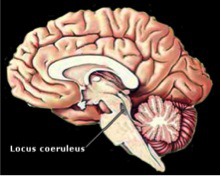
Where does the norepinephrine system originate from?

answer
The locus coeruleus
question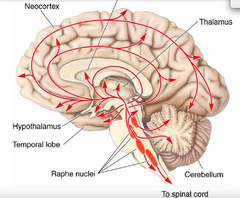
Where does the serotonin system originate from? Where is it located?

answer
the raphe nuclei
question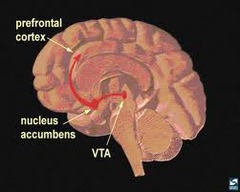
Where does the dopamine system originate from?

answer
the ventral tegmental area (VTA)
question
6 brain regions that seem to be most involved in the expression of human emotion
answer
1. Prefrontal Cortex 2. Amygdala 3. Hippocampus 4. Ventral Striatum (nucleus accumbens) 5. Cinculate Cortex 6. Insular Cortex
question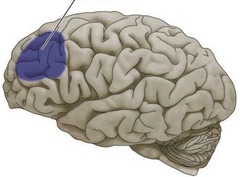
What does the prefrontal cortex do? Where is it located?

answer
-stores memories of the consequence of behaviors or experiences that were aversive or pleasurable -this permits an emotion to be sustained long enough to direct behavior toward the goal that is appropriate for that emotion
question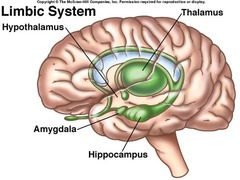
What does the amygdala do? Where is it located?

answer
-plays a key role in integrating overt behavior, autonomic responses, and hormonal responses during stress and emotion -it influences the pleasantness or unpleasantness of a situation
question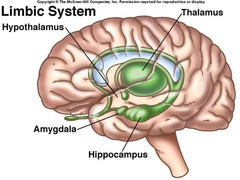
What does the hippocampus do? Where is it located?

answer
-processes memories of the environmental context in which emotion occurs before those memories are stored in the brain region where they were experienced
question
The _______ contains the nucleus accumbens.
answer
basal ganglia
question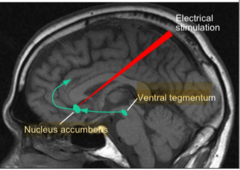
What does the nucleus accumbens do? Where is it located?

answer
-it's in the pathway of dopamine neurons in the midbrain that are key in what is known as reward-motivated behavior -plays a role in regulating approach behaviors that result in pleasure (drive, urges, cravings)
question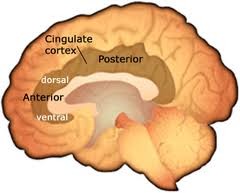
What does the cingulate cortex do? Where is it located?

answer
-helps regulate attention during the processing of pleasure or displeasure during an emotion -also called "the old brain" -helps us control our rage
question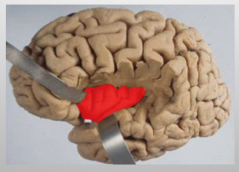
What does the insular cortex do? Where is it located?

answer
-receives sensory inputs from the autonomic nervous system, especially cardiovascular responses, and sends signals to the central amygdala and the hypothalamus, which each regulate cardiac and endocrine responses during stress
question
What is the ventral tegmental area (VTA)?
answer
a group of neural cell bodies in the underside of an area at the top of the brain stem, between the pons and the 4th ventricle of the brain
question
What do antidepressant drugs do to the re-uptake mechanisms of neurotransmitters and why is that beneficial?
answer
They block the re-uptake mechanisms in order to allow the neurotransmitter to stay in the synapse longer.
question
What parts of the brain have increased opioid activity with exercise?
answer
1. Orbitofrontal Cortex 2. Insular Cortex 3. Anterior Cingulate Cortex
question
Drugs that reduce depression work by inhibiting what transporter? What does it do?
answer
Norepinephrine transporter It leaves the norepinephrine that has been released in the synapse for longer in hopes of it getting taken up for use
question
What do BZDs do for anxiety?
answer
They have the ability to open chloride channels but only in the regions of the brain where fear and anxiety occur



